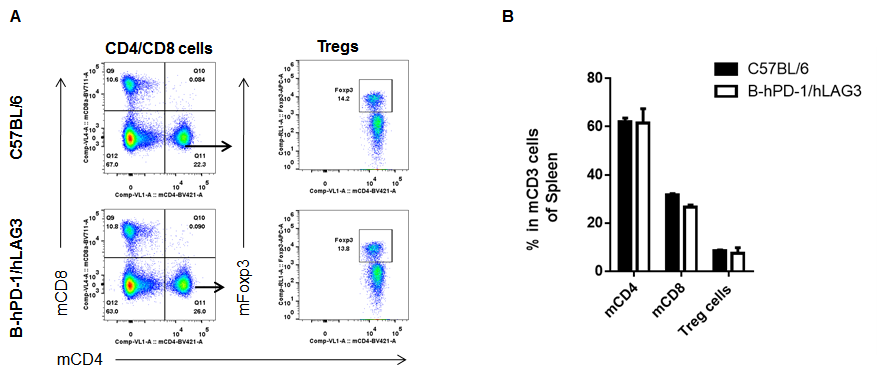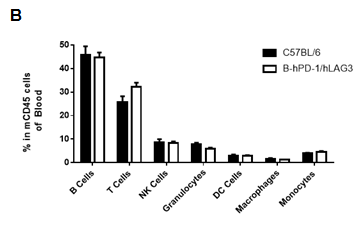| Strain Name |
C57BL/6-Pdcd1tm1(PDCD1)Bcgen Lag3tm1(LAG3)Bcgen/Bcgen
|
Common Name | B-hPD-1/hLAG3 mice |
| Background | C57BL/6 | Catalog number | 120520 |
|
Related Genes |
PD-1 (Programmed death-1) ; LAG3 (Lymphocyte activation gene 3, CD223) |
||
|
NCBI Gene ID |
18566,16768 | ||
Protein expression analysis

Strain specific PD-1 and LAG3 expression analysis in homozygous B-hPD-1/hLAG3 mice by flow cytometry. Splenocytes were collected from WT and homozygous B-hPD-1/hLAG3 (H/H) mice stimulated with anti-CD3ε in vivo, and analyzed by flow cytometry with species-specific anti-PD-1 and anti-LAG3 antibody. Mouse PD-1 and LAG3 were detectable in WT mice while mouse LAG3 was also detectable in homozygous B-hPD-1/hLAG3, due to the anti-mouse LAG3 antibody cross-reacts with human LAG3. Human PD-1 and LAG3 were exclusively detectable in homozygous B-hPD-1/hLAG3 but not WT mice.
Analysis of spleen leukocytes cell subpopulations in B-hPD-1/hLAG3 mice


Analysis of spleen leukocyte subpopulations by FACS
Splenocytes were isolated from female C57BL/6 and B-hPD-1/hLAG3 mice (n=3, 6 week-old) Flow cytometry analysis of the splenocytes was performed to assess leukocyte subpopulations. A. Representative FACS plots. Single live cells were gated for CD45 population and used for further analysis as indicated here. B. Results of FACS analysis. Percent of T, B, NK, Monocyte, DC and macrophage cells in homozygous B-hPD-1/hLAG3 mice were similar to those in the C57BL/6 mice, demonstrating that introduction of hPD-1/hLAG3 in place of its mouse counterpart does not change the overall development, differentiation or distribution of these cell types in spleen.
Analysis of spleen T cell subpopulations in B-hPD-1/hLAG3 mice

Analysis of spleen T cell subpopulations by FACS
Splenocytes were isolated from female C57BL/6 and B-hPD-1/hLAG3 mice (n=3, 6 week-old). Flow cytometry analysis of the splenocytes was performed to assess leukocyte subpopulations. A. Representative FACS plots. Single live CD45+ cells were gated for CD3 T cell population and used for further analysis as indicated here. B. Results of FACS analysis. Percent of CD8, CD4, and Treg cells in homozygous B-hPD-1/hLAG3 mice were similar to those in the C57BL/6 mice, demonstrating that introduction of hPD-1/hLAG3 in place of its mouse counterpart does not change the overall development, differentiation or distribution of these T cell sub types in spleen. Values are expressed as mean ± SEM.
Analysis of blood leukocytes cell subpopulations in B-hPD-1/hLAG3 mice


Analysis of blood leukocyte subpopulations by FACS. Blood were isolated from female C57BL/6 and B-hPD-1/hLAG3 mice (n=3, 6 week-old) Flow cytometry analysis of the blood leukocytes was performed to assess leukocyte subpopulations. A. Representative FACS plots. Single live cells were gated for CD45 population and used for further analysis as indicated here. B. Results of FACS analysis. Percent of T, B, NK, Monocyte, DC and macrophage cells in homozygous B-hPD-1/hLAG3 mice were similar to those in the C57BL/6 mice, demonstrating that introduction of hPD-1/hLAG3 in place of its mouse counterpart does not change the overall development, differentiation or distribution of these cell types in spleen.
Analysis of blood T cell subpopulations in B-hPD-1/hLAG3 mice

Analysis of blood T cell subpopulations by FACS
Blood were isolated from female C57BL/6 and B-hPD-1/hLAG3 mice (n=3, 6 week-old). Flow cytometry analysis of the blood leukocytes was performed to assess leukocyte subpopulations. A. Representative FACS plots. Single live CD45+ cells were gated for CD3 T cell population and used for further analysis as indicated here. B. Results of FACS analysis. Percent of CD8, CD4, and Treg cells in homozygous B-hPD-1/hLAG3 mice were similar to those in the C57BL/6 mice, demonstrating that introduction of hPD-1/hLAG3 in place of its mouse counterpart does not change the overall development, differentiation or distribution of these T cell sub types in spleen. Values are expressed as mean ± SEM.
Blood routine test in B-hPD-1/hLAG3 mice

Complete blood count (CBC). Blood from female C57BL/6 and B-hPD-1/hLAG3 mice (n=3, 6 week-old) was collected and analyzed for CBC. There was no differences among any measurement between C57BL/6 and B-hPD-1/hLAG3 mice, indicating that introduction of hPD-1/hLAG3 in place of its mouse counterpart does not change blood cell composition and morphology. Values are expressed as mean ± SEM.
Combination therapy of anti-human PD-1 antibody and anti-human LAG3 antibody










